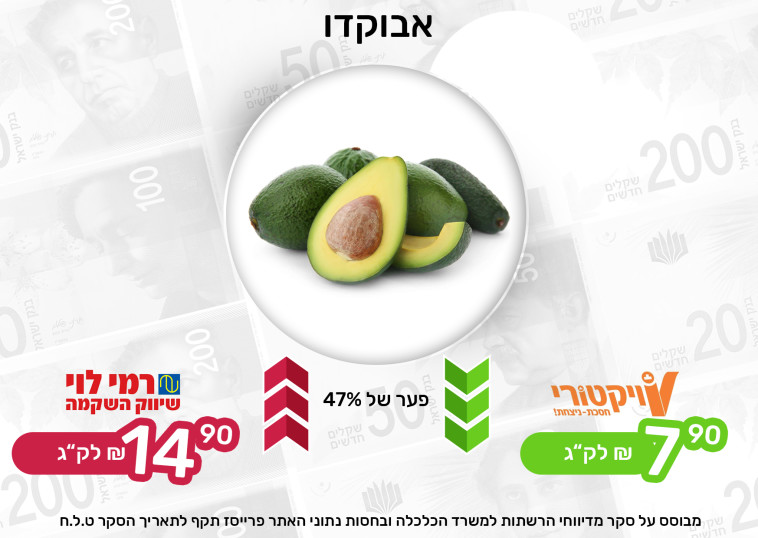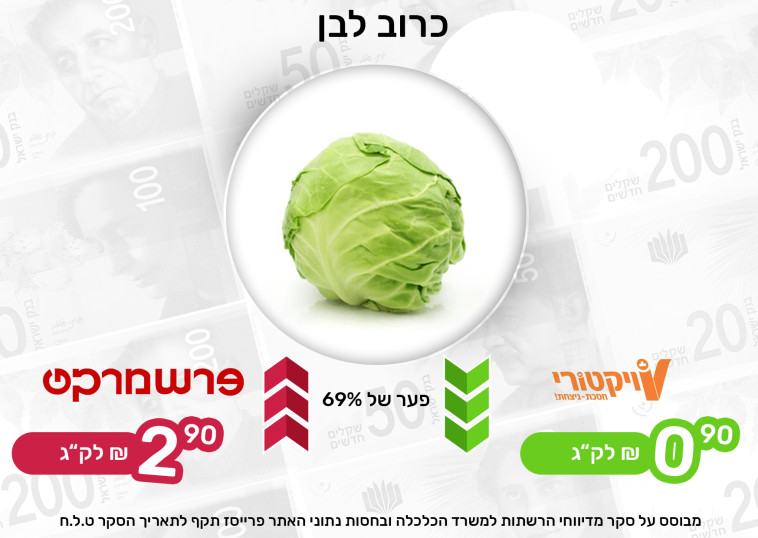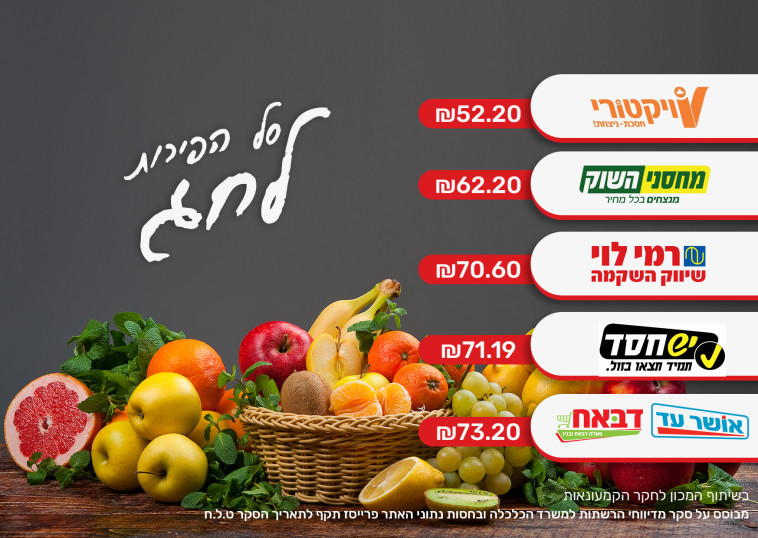Many articles have recently been published about agricultural produce in Israel, which have raised arguments and reflected disagreements regarding the problem of imports and the opening of the economy to agricultural imports in the face of the neglect of farmers in Israel. The corona period led to the destruction of crops due to demand from the institutional market, but despite all this, the prices of vegetables and fruits did not fall and even rose.
The volume of sales in the vegetable and fruit segment is about 11% of the total turnover of the food chains, and during the holidays the sales contribution also jumps to 15% of the total cost of the shopping basket. The culture of consuming vegetables and fruits in Israel is of a different nature from European and American countries: we are large consumers of vegetables and fruits, and while many countries consume vegetables and fruits in units, we buy them in kilograms, and if the offer is attractive – we buy in quantities considered commercial in many countries. Fresh vegetables are popular in restaurants and cafes, and the fruits in our lives are not only a substitute for a snack but have already become a dessert after every meal.The problem is that vegetables and fruits have changed from basic and cheap foods to those that sometimes do not fall short of other meats and delicacies.
Fighting for the consumer
For many years now, the war for the consumer’s pocket has begun with the management of price competition for vegetable and fruit products. The two leading and most common products in every shopping basket are tomato and cucumber, so the emphasis on price is critical: many chains have adopted the term “market day”. What is Market Day for? It is designed to stimulate us, the consumers, through promotions in the vegetable and fruit department, so that we are tempted to buy the whole (sometimes the other departments will “complete” the discount we enjoyed – at high prices or promotions that require a certain amount to enjoy the fruit and vegetable promotion).
Food prices in the country are affected by several variables, some of the influencing raw materials such as oil, sugar, rice and wheat are traded on the World Stock Exchange. Other influencers are the oil and electricity used for the manufacturing industry. The costs of transportation and air and sea transportation also affect the cost of the product, but what is the difference between the effects and price changes between the various food products and the fresh products from the plant? The dynamics of price changes in fresh plant products has daily fluctuations (sometimes even more than once a day).
 Avocado price comparison (Photo: Maariv Online)
Avocado price comparison (Photo: Maariv Online)Thus, for example, an increase in sugar prices may affect the prices of a large part of food products, but this effect will not be immediate, since the stocks in the warehouses were bought according to the old price. In contrast, when it comes to fruits and vegetables, trading is daily. Prices of fresh produce are affected by a large number of variables – supply and demand, manpower availability, weather, morbidity, events and dates, and of course, the product having a very short shelf life. That is, if the produce is not sold, it is destroyed. The amount of produce destroyed in the marketing chains is not negligible, and the amount of produce destroyed by farmers and marketers is even higher. Since this is a product whose shelf life is short, it is impossible to hold its stock and certainly not commit to a fixed price for long periods of time. Try to imagine that with every purchase you make at the supermarket, the prices of milk and coffee would change.
Price at the expense of quality
A retailer can buy tomatoes on Sunday at a price of NIS 2 per kg, and on Monday their price can jump to NIS 5 per kg (and vice versa, of course). This is one of the other reasons for the market days in the chains. Consumers expect surprises and benefits in this area, and a high percentage of us follow vegetable prices.
Are the differences in vegetable and fruit prices the only difference we need to address?
Suppose we were exposed to an attractive operation of a food marketing chain. Yesterday we bought a tomato for NIS 4.90 per kg, and today there is advertising for NIS 2.90 per kg. What are we supposed to feel and think? Did the same chain sell us at exorbitant prices? Maybe vegetable and fruit prices have dropped today? And maybe this is a benefit and an irreversible opportunity to enjoy a discounted price for our basket of vegetables and fruits?
I asked Doron Yitzhaki, one of the owners of the Free Food chain, why there are such gaps and what the difference is. Yitzhaki replied that although he runs a medium-sized food chain in terms of its trading volume, he is fighting with the big chains in prices. Conversely, when it comes to fresh goods, once the price comes at the expense of quality, the customer points with his feet and does not want to compromise. Despite this, there are many customers who do not always know how to distinguish between different varieties and the quality of the goods, for example: a Smith-type apple can range from NIS 5 per kilogram to NIS 11 per kilogram. The price is what makes the initial impression on the customer, and only then does he examine the goods. Yitzhaki: “I come across many retailers who are tempted to offer poor goods for a low price, but it turns out that the Israeli consumer understands and does not compromise, and in the end they experience damage to business activity and store image. The number of varieties, even tomatoes, is huge. “Tomato is ‘beautiful or not beautiful’, but there are huge differences between the different varieties, in size, shape and of course in taste.”
 Price comparison of green cabbage (Photo: Maariv Online)
Price comparison of green cabbage (Photo: Maariv Online)Therefore, when we see a tomato at a price of NIS 1.90 per kg and a tomato at a price of NIS 4.90 per kg, we must be aware of things such as:
- Just before the 2021 elections: Senior members of the 2021 parties answer the difficult questions
- Why is there a gap between chain and chain and from store to store?
- Does one network only want to do good with the buyer while the competing network intends to oppress it?
- Is it really the same strain and the same quality?
- Is price just a means to attract customers?
- Is the price of the promotion conditional or dependent on various restrictions or may it be valid for a short time such as a day or even an hour?
Consumer prices are often offered less than the retail cost price to attract the buyer’s attention and lead him to purchase a full shopping basket, as this is a key parameter in Israeli culinary existence: there is no holiday table without vegetables and fruits, and for many of us, there is no day not to eat fruit and vegetables. The question is how much we will pay for the basket of vegetables and fruits and whether the basket is the same in nature and varieties between chains and even from store to store. From experience I can tell you unequivocally not: neither the tomato nor the cucumber bears a unique hallmark or barcode so that we can identify the varieties or the quality. We therefore have to rely on the appearance of eyes and the accumulated experience we have gained.
There are offers for the sale of packaged fruits and vegetables in the retail chains with a unique identification mark and barcode, which are also designed to preserve the environment and save on plastic bags. All of this may happen in the future. Meanwhile buying fruits and vegetables is dominant in shaping our shopping experience: the touch, the gathering and the feeling of “the market” are part of the customer’s stimulus in the store.
And now, to the big question: in which marketing chains would it be most profitable to purchase vegetables and fruits?
 Ranking of the vegetable basket for Passover (Photo: Maariv Online)
Ranking of the vegetable basket for Passover (Photo: Maariv Online) Ranking of the fruit basket for Passover (Photo: Maariv Online)
Ranking of the fruit basket for Passover (Photo: Maariv Online)Stores that participated in the survey: Victory Hadera, Shufersal Deal Yachin Petah Tikva, Dabah Ein Hamifratz, Osher Ad Bnei Brak, Rami Levy Kiryat Shmona, Bashar Market Market Warehouses, Yohananoff Kfar Saba, Fresh Market Lahav Hasharon Mall, Mega Market Raanana Semi-free Rishon LeZion, Tiv Ta’am Rishon LeZion
The survey is based on the networks’ reports to the Ministry of Economy and under the auspices of the Prices website in collaboration with the Institute for Retail Research and as of March 15, 2121 TLH
* The author is the founder and CEO of the Institute for Retail Research
